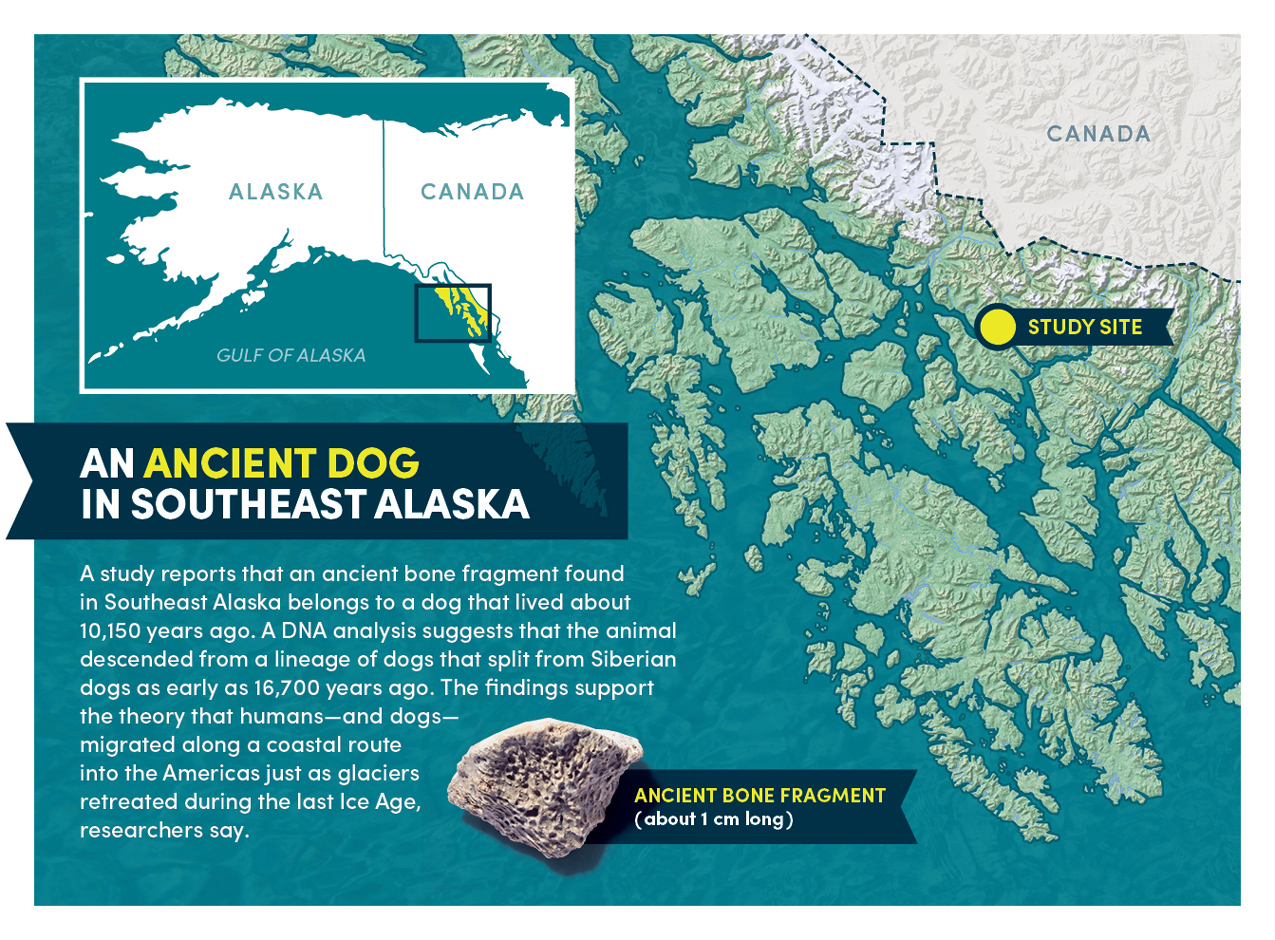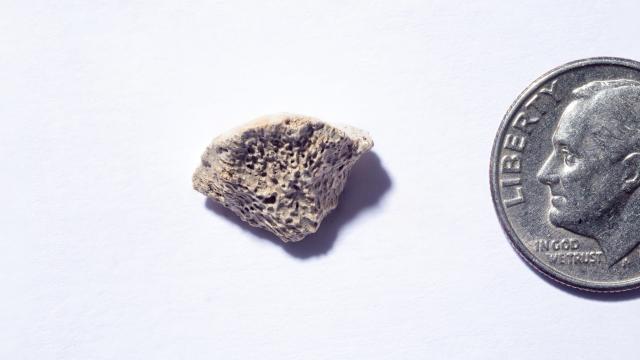A fragment of 10,000-year-old dog bone found along the Alaskan coast could be the oldest evidence of domesticated dogs in North America, and potential evidence of a coastal route taken by the first people to cross into North America from Eurasia.
The evidence continues to mount for the Coastal Migration Theory, which proposes that Eurasian migrants, instead of travelling through an interior corridor between two melting ice sheets, hugged the Siberian, Beringian, and Alaskan coastlines. These settlers continued their way along the Pacific coast, eventually reaching the southernmost boundary of the massive Cordilleran Ice Sheet, according to this theory.
The Coastal Migration Theory, also known as the Kelp Highway Hypothesis, is supported by geological and archeological evidence, including 29 human footprints found on the shoreline of Calvert Island in British Columbia. We now have further evidence to support this theory, but it comes from an unexpected source: a domesticated dog.

This dog died approximately 10,150 years ago in what is now Alaska during the very tail-end of the last Ice Age. The lone fossil — a piece of a femur — is now the oldest confirmed remnant of a domesticated dog in the Americas, according to the new research, led by evolutionary biologist Charlotte Lindqvist from the University at Buffalo. The paper describing this discovery was published on Tuesday in Proceedings of the Royal Society B.
That Alaska was hosting dogs around this time is not a huge surprise. Research from 2019 presented evidence of three prehistoric dogs found buried in what is now Illinois, which were dated to between 9,630 and 10,190 years ago, the latter figure suggesting a date slightly older than the date presented for the femur in the new paper. I asked Lindqvist about this apparent discrepancy.
[referenced id=”1144771″ url=”https://gizmodo.com.au/2019/01/new-evidence-suggests-dogs-reached-north-america-10000-years-ago/” thumb=”https://gizmodo.com.au/wp-content/uploads/2019/01/10/ofixz59bxrspxhp15vdi.jpg” title=”New Evidence Suggests Dogs Reached North America 10,000 Years Ago” excerpt=”The skeletal remains of three ancient dogs found buried in Illinois now represent the earliest evidence for the presence of domesticated dogs in the Americas. It’s also the oldest known intentional burial of individual canines in the global archaeological record.”]
“When you compare the median radiocarbon dates of the Illinois dogs and our dog, the Alaskan dog is a little older,” she said. “But it does depend on what you are comparing, and with the error bars and uncertainty — and radiocarbon dating done by different labs — you can argue that they are at least close to the same age, possibly with the Alaskan dog being a couple hundred years older.”
The Illinois dogs are significant, because they suggest the first settlers of North America brought their dogs with them from Eurasia. Previous genetic research done in this area came to a similar conclusion, showing that dogs arrived in the Americas approximately 10,000 years ago.
Lindqvist and her colleagues inadvertently stumbled upon the femur while sequencing DNA from a jumble of animal bones excavated from caves in southeast Alaska. This research is being done to determine how climatic changes during the last Ice Age affected various species, including their mobility.
“One of the projects I work on involves black and brown bears and we initially thought the bone came from a bear, but we later discovered it was a dog, and we had to follow up on this finding,” explained Lindqvist in an email.
The canine femur fragment, designated PP-00128, was found on the southeast Alaskan mainland just east of Wrangell Island in a location known as Lawyer’s Cave. Lindqvist, with her co-author Timothy Heaton, a professor of Earth sciences at the University of South Dakota, conducted a number of excavations in the late 1990s and early 2000s, resulting in the discovery of this bone and many others from this same cave.

The team was able to derive a complete mitochondrial genome from the fragment, which they compared to modern dog breeds, historical Arctic dogs, and American pre-contact dogs (i.e. dogs that lived in the Americas prior to the arrival of Europeans). Mitochondrial DNA comes exclusively from the maternal side, so it’s incomplete (as compared to nuclear DNA), but the scientists were able to trace the genome back to a lineage that diverged from Siberian dogs around 16,700 years ago.
That’s significant, as this “timing roughly coincides with the minimum suggested date for the opening of the North Pacific coastal route along the Cordilleran Ice Sheet and genetic evidence for the initial peopling of the Americas,” as the authors wrote in the study.
Indeed, the PP-00128 fragment presents another clue in favour of the Coastal Migration Hypothesis. The coastal edge of the ice sheet started to melt around 17,000 years ago, while the inland corridor didn’t open up until around 13,000 years ago.
“Previous genetic estimates of the split between pre-European American dogs and their Siberian ancestors were younger than the estimates of when the ancestral native American human population diverged from their Siberian ancestors, suggesting dogs arrived in later migrations of humans into the Americas, perhaps even along the inland corridor,” explained Lindqvist.
Before the new study, “the oldest American dog remains were found from mid-continent sites, not suggesting how they got there,” she said, but this latest discovery “supports that our coastal dog is a descendant of dogs that participated in this initial migration along the Northwest Pacific Coast.”
A possibility exists, of course, that this was a rogue dog that somehow made its way to North America without humans. That’s not as outlandish as it might seem; dogs were domesticated from wolves between 14,000 and 29,000 years ago, in a complex process that involved multiple interbreeding episodes between dogs and wild wolves. That said, Lindqvist believes her Alaskan dog likely lived with humans.
“Other remains excavated from this same cave include human bones and artifacts, but these are all younger,” she said. “They do suggest, though, that the cave was indeed used by humans. And we know from human remains found in another cave in southeast Alaska that humans were in the region at the time this ancient dog lived. But no, we don’t have direct evidence that this dog was living with humans. We do know, though, that this dog was a domesticate and not a wolf, and if I were a dog, I would probably stay around humans for food.”
[referenced id=”1662587″ url=”https://gizmodo.com.au/2021/01/too-much-meat-during-ice-age-winters-gave-rise-to-dogs-new-research-suggests/” thumb=”https://gizmodo.com.au/wp-content/uploads/2021/01/08/b3dxmujiw1s6rkwuju9z-300×168.jpg” title=”Too Much Meat During Ice Age Winters Gave Rise to Dogs, New Research Suggests” excerpt=”Two prevailing theories exist about the origin of domesticated dogs. One proposes that prehistoric humans used early dogs as hunting partners, and the other says that wolves were attracted to our garbage piles. New research suggests both theories are wrong and that the real reason has to do with our…”]
Indeed, a carbon isotope analysis of the femur fragment suggests this dog was fed by humans, as it ate fish (possibly salmon), and meat from whales and seals. This runs in stark contrast to other ancient dogs living in the mid-continent, which featured a “much more terrestrial diet,” said Lindqvist.
That humans travelled along the Pacific coast from Eurasia into North America seems highly probable, and the new research fits in nicely with this increasingly popular narrative. But that doesn’t mean alternate pathways into the continent were neglected. As previous research shows, there was likely more than one route into North America, as an interior corridor likely opened up around 12,600 to 13,100 years ago.
